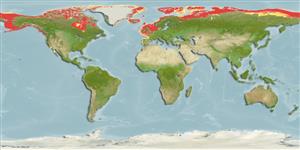Nymphon brevitarse Kroyer, 1838
| Native range | All suitable habitat | Point map | Year 2050 |

|
| This map was computer-generated and has not yet been reviewed. |
| Nymphon brevitarse AquaMaps Data sources: GBIF OBIS |
Upload your photos
Google image |
No photo available for this species.No drawings available for Nymphonidae.
Google image |
No photo available for this species.
Classification / Names Common names | Synonyms | CoL | ITIS | WoRMS
Pycnogonida | Pantopoda | Nymphonidae
Environment: milieu / climate zone / depth range / distribution range Ecology
Benthic. Subtropical
Distribution Countries | FAO areas | Ecosystems | Occurrences | Introductions
Pacific and Arctic Oceans.
Length at first maturity / Size / Weight / Age
Maturity: Lm ? range ? - ? cm
Short description Morphology
Trunk robust, lateral processes short, little longer than diameters, separated by less than diameters, with few short posterodistal setae. Ocular tubercle very low, eyes filling most of tubercle. Proboscis short, cylindrical, oral surface rounded. Abdomen moderately short, erect. Chelifore scapes robust, slightly curved, chelae palms robust, fingers shorter than palm, with small short teeth. Palps quite short, second segment only about 3 times longer than its width, distal segments each shorter. Legs moderately long, with many short setae and spines, few longer than segment diameters. Tarsus almost as long as propodus. Propodus with 5 larger sole spines, several smaller distal spines. Auxiliary claws little less than half main claw length. Appendages show much variability (Ref. 2153, p. 20).
Shelf to slope (Ref. 19).
Life cycle and mating behavior Maturity | Reproduction | Spawning | Eggs | Fecundity | Larvae
Members of the class Pycnogonida are gonochoric and sexually dimorphic. During copulation, male usually suspends itself beneath the female. Fertilization occurs as the eggs leave the female's ovigers. Males brood the egg masses until they hatch. Life cycle: Eggs hatch into protonymphon larva then to adults.
Main reference
References | Coordinator | Collaborators
Child, C.A. 1996. (Ref. 2117)
IUCN Red List Status (Ref. 130435)
CITES status (Ref. 108899)
Not Evaluated
CMS (Ref. 116361)
Not Evaluated
Threat to humans
Human uses
| FishSource |
Tools
More information
Internet sources
BHL | BOLD Systems | CISTI | DiscoverLife | FAO(Publication : search) | Fishipedia | GenBank (genome, nucleotide) | GloBI | Gomexsi | Google Books | Google Scholar | Google | PubMed | Tree of Life | Wikipedia (Go, Search) | Zoological Record
Estimates based on models
Preferred temperature
(Ref. 115969): -1.5 - 7.7, mean 0.4 (based on 1705 cells).
Price category
(Ref. 80766):
Unknown.


